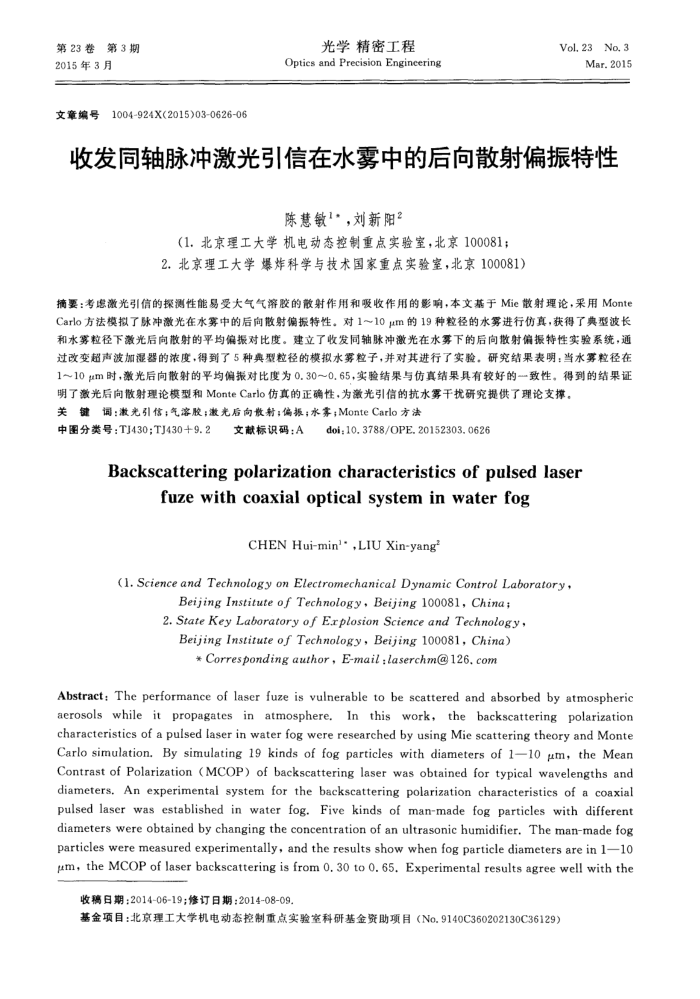收发同轴脉冲激光引信在水雾中的后向散射偏振特性
内容简介
 第3期
第3期2015年3月
文章编号
1004-924X(2015)03-0626-06
光学精密工程
Optics and Precision Engincering
Vol. 23No.3
Mar.2015
收发同轴脉冲激光引信在水雾中的后向散射偏振特性
陈慧敏1.,刘新阳2
(1.北京理工大学机电动态控制重点实验室,北京100081: 2.北京理工大学爆炸科学与技术国家重点实验室,北京100081)
摘要:考虑激光引信的探测性能易受大气气溶胶的散射作用和吸收作用的影响,本文基于Mie散射理论,采用Monte Carlo方法模拟了脉冲激光在水雾中的后向散射偏振特性。对1~10μm的19种粒径的水雾进行仿真,获得了典型波长和水雾粒径下激光后向散射的平均偏振对比度。建立了收发同轴脉冲激光在水雾下的后向散射偏振特性实验系统,通过改变超声波加混器的浓度,得到了5种典型粒径的模拟水雾粒子,并对其进行了实验。研究结果表明:当水雾粒径在 1~10um时,激光后向散射的平均偏振对比度为0.30~0.65,实验结果与仿真结果具有较好的致性。得到的结果证
明了激光后向散射理论模型和MonteCarlo仿真的正确性,为激光引信的抗水雾干扰研究提供了理论支撑。关键调:激光引信;气溶胶;激光后向散制;偏振;水雾;MonteCarlo方法
中图分类号:TJ430;TJ430+9.2
文献标识码:A
doi:10.3788/OPE.20152303.0626
Backscatteringpolarizationcharacteristicsofpulsedlaser
fuzewithcoaxialopticalsysteminwaterfog
CHENHui-min'',LIUXin-yang
(l.Scienceand Technology onElectromechanical Dynamic Control Laboratory,
Beijing Institute of Technology,Beijing l0008l,China; 2.State Key Laboratory of Erplosion Science and Technology, BeijingInstitute ofTechnology,Beijing100081,China) Correspondingauthor,E-mail:laserchm@126.com
Abstract: The performance of laser fuze is vulnerable to be scattered and absorbed by atmospheric aerosols while it propagates in atmosphere.In this work, the backscattering polarization characteristics of a pulsed laser in water fog were researched by using Mie scattering theory and Monte Carlo simulation. By simulating 19 kinds of fog particles with diameters of 1—10 μm, the Mean Contrast of Polarization (MCOP) of backscattering laser was obtained for typical wavelengths and diameters, An experimental system for the backscattering polarization characteristics of a coaxial pulsed laser was established in water fog.Five kinds of man-made fog particles with different diameters were obtained by changing the concentration of an ultrasonic humidifier. The man-made fog particles were measured experimentally, and the results show when fog particle diameters are in 1—10 μm, the MCOP of laser backscattering is from 0.30 to 0. 65.Experimental results agree well with the
收稿日期:2014-06-19;修订日期:2014-08-09
基金项目:北京理工大学机电动态控制重点实验室科研基金资助项目(No.9140C360202130C36129)
上一章:基于环境智能的老人健康照护系统设计
下一章:基于空间依存的无参考图像质量评价